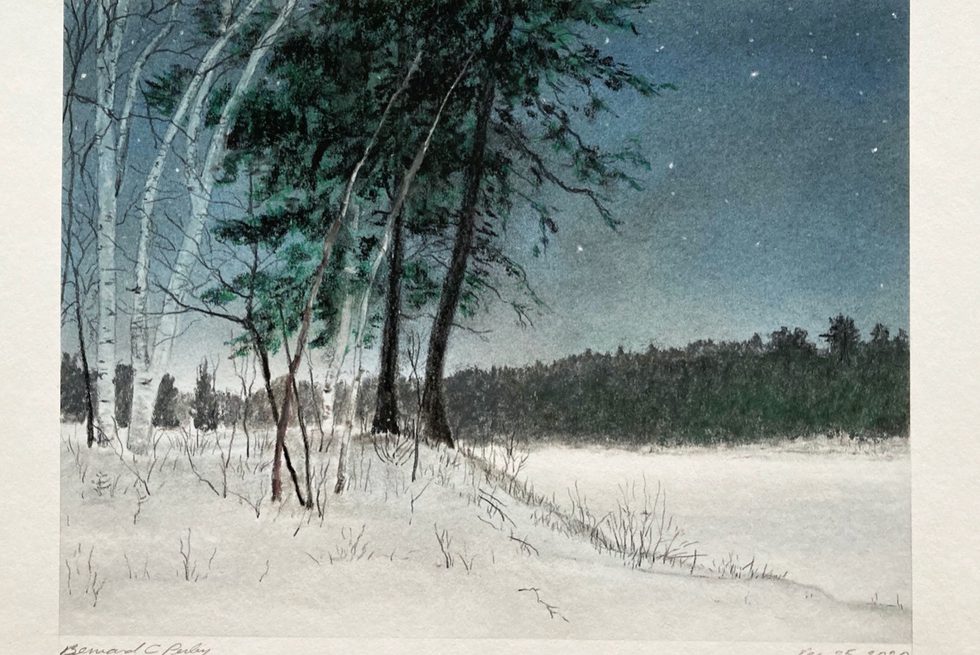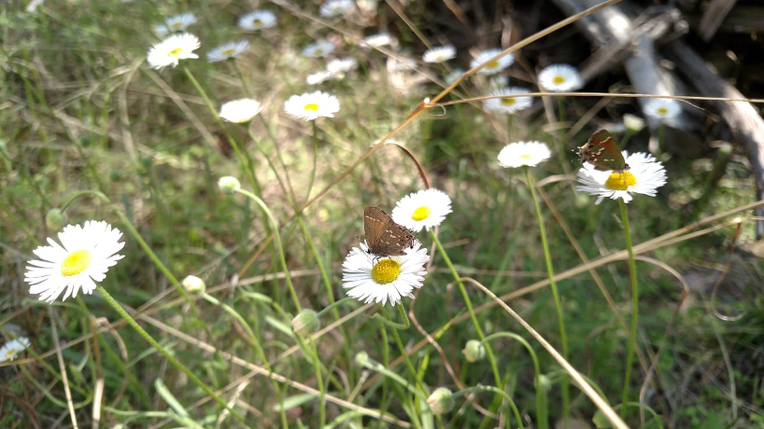Air, Mirrorworld
From the Series: Art and Ethnographic Forms in Dark Times
From the Series: Art and Ethnographic Forms in Dark Times


This piece shifts among ways of sense-making of monarch butterfly conservation efforts in Texas, which prompt citizen scientists and ranchers to plant pollinator gardens and tally monarch deaths on their windshields.
It lands on a stem of milkweed.
The flutter is cataloged as data, to be googled later.
I scratch enough pen marks along the petal that it changes shape.
The only advice I have received about drawing is that one should “draw the relationships among things,” and not the thing.
What is the there there in a meticulous description of petals, wings, wind patterns?
Their undoing, or unworlding in the act of description.
That “certain ways of looking . . . can erase the intimacy and stability of those relations” (Romanillos 2008, 798).
Nabokov unclassified the Polyomattus blue butterfly, the Karner blue butterfly, by examining its genitalia.
His theory about their migration patterns proved to be true, but no one in the scientific community took it seriously in his time.
Quantum theory offers that a wave is a movement from equilibrium (undulation theory).
(How things come to rhythm.)
Sounding is an event—memory is an action of this coherence.
Sensory thresholds demand the plasticity of the subject and their extension into what Kathryn Yusoff (2015) describes as the “insensible” intimacies of the anthropocene—such as invisible methane emissions, infrasound, carbon monoxide, or fracking quakes that comprise a sensoria beyond the human as reliable measure of its stability.
Monarch butterflies sense magnetic fields, emerging through its atmospherics—a micro-thinking through the gestural, rather than a provisional context from which to read or situate it as an ethnographic subject.
The threshold of a thing’s expressivity has to do with these perceived exteriors, surfaces that scrub each other of subjectivity—narratives which are endlessly mutable in time.
Unrhythming a thing as the wind picks up in unpredictable variation—undulations—minor events of weather, sneezing, and having to pee—
how “sometimes the movement of description obliterates the thing described” (Romanillos 2008, 806).
In this infra-register, there is a more expansive relationship to energy beyond its purview as “fuel” (Daggett 2019) as biorhythms, light and sonic spectrums, electromagnetic and gravitational fields, jet streams, flyways and subterranean currents, gases.
(Letting go the emphasis on things, on entities, on particles, on objects, on species to think through forces, rhythms, heterogeneous temporalities—primacies of motion.)
A poetics of this infra-materiality destabilizes the bounded human subject—“I”—toward the radical indeterminacy of matter and mattering, of air (see Choy 2011).1
Is there a difference in the subtleties of shaking or trembling or vibrating as it disaggregates matter from its abstractions in shapes, or time?
There is the question of what is an observable phenomena—writing in the present tense—whether at the center of everyone is an atmosphere of innocence waiting to be classified—
Similarly, what is an essay that is just a series of motions, edges, or echoes of something—gestures toward but never things that are? Deciding what it is about when it isn’t “about anything.”
The nonsubject Helene Cixous (1991, 124) describes as central to both Monet’s impressionism and Clarice Lispector’s philosophy, “One does not paint water lilies. And the same way: no writing ideas. There is no subject. There are only mysteries. There are only questions . . . ”
Ethnographic coherence around these rhythms articulates delicate empirical holds, durations, and events.
The details are less important than the eeriness of their specificity when recalled.
Becomes this monarch crossing this road, becomes the moment we stopped to look at the wildflowers—Argemone albiflora, white prickly poppy—where tiny versions of butterflies landed, “wannabe monarchs,” said R, and we commented on the tininess of things, and I thought these were the type of daisies one makes chains or crowns or necklaces out of, and I imagined myself as a child, splitting their stems lengthwise to make incisions for the slip of another daisy stem, on and on to fit the size of my head, also tiny, even taking breaks to suck the blue juice from a freeze-pop—
it’s already hot out in April in Texas and the wind is enough to sound like static as it hits the nylon fabric of my jacket, the bearded and bluestem grasses, the wooden wind chimes in the front yard of the hippie retreat center down the road, draped in multicolored xmas lights 24/7 365,
R whistles something and the chihuahua has this look on her face, running back to where we stopped for daisies and tiny butterflies.
In the act of description, a concern for what is being left out—heaving around the care for details I could mention but don’t know enough about, such as what season the sky was in that evening, or what were newsworthy events, or what social media had to say about what celebrity died and the rollout of vaccines and weather that week or around the world, and who or what else is sensing the thing at the moment—
all the other species, microbes or whatevers in the soil and in the air that do not care about anthropologists, and all the other thoughts that passed through me like neutrinos through the sun, or my friend, or the dog,
and all the other phenomena I processed, but in memory only have images,
pollen-thoughts, or an “inventory of shimmers” (Seigworth and Gregg 2010). Nonhistorical “events” that nonetheless become so in the revisions, regrets that something had been missed in the telling, that how did we get here, with its emphasis on a spatiotemporal territory, here, a refrain for forgetting, if only—involving a “complex we” (de la Cadena 2019)
and how this kind of thinking leads to its anxiety of the simultaneity of events in spaces that are not seen, in times barely shared, but this is neither ethnographic nor empirical—just dreamy, or delicate.
Memory is less involuntary than “insensible,” where the sensory prompts both its dissimulation and indicates the malleability of something like time.
The Texas Department of Transportation agrees about the highway danger.
The butterfly activists ask us to write down how many butterflies are splattered on the windshield, squished in the grooves of our tires.
I feel informed about the butterfly’s vulnerability to wind—clinging in collective clusters to trees, using its tactile setae to sense vibrations in the air, knocked off course by dust, by storms, by methane emissions.
Disappearing in gusts as its milkweed fails to germ.
Scrubbed of surface in the way that if the subject is unrecognizable, at least it is mobile, and mutable—soft like usnea florida, old man’s beard, a lichen that grows everywhere: first classified by Linneaus, now endangered.
1. “For the notion of a poetics of place to have any teeth, for it to do more than just legitimate linguistic study of something linked to the material world, we must go after the nonverbal ways air operates poetically” (Choy 2011, 137).
Choy, Tim. 2011. Ecologies of Comparison: An Ethnography of Endangerment in Hong Kong. Durham, N.C.: Duke University Press.
Cixous, Hélène. 1991. “Coming to Writing” and Other Essays. Edited by Deborah Jenson. Cambridge, Mass.: Harvard University Press.
Daggett, Cara New. 2019. The Birth of Energy: Fossil Fuels, Thermodynamics, and the Politics of Work (Elements). Durham, N.C.: Duke University Press.
de la Cadena, Marisol. 2019. “An Invitation to Live Together: Making the ‘Complex We.’” Environmental Humanities 11, no. 2: 477–84.
Romanillos, José Luis. 2008. “‘Outside, it is snowing’: Experience and Finitude in the Nonrepresentational Landscapes of Alain Robbe-Grillet.” Environment and Planning D: Society and Space 26, no. 5: 795–822.
Seigworth, Gregory J., and Melissa Gregg. 2010. “An Inventory of Shimmers.” In The Affect Theory Reader, edited by Melissa Gregg and Gregory J. Seigworth, 1–27. Durham, N.C.: Duke University Press,.
Yusoff, Kathryn. 2013. “Insensible Worlds: Postrelational Ethics, Indeterminacy and the (k)Nots of Relating.” Environment and Planning D: Society and Space 31, no. 2: 208–26.